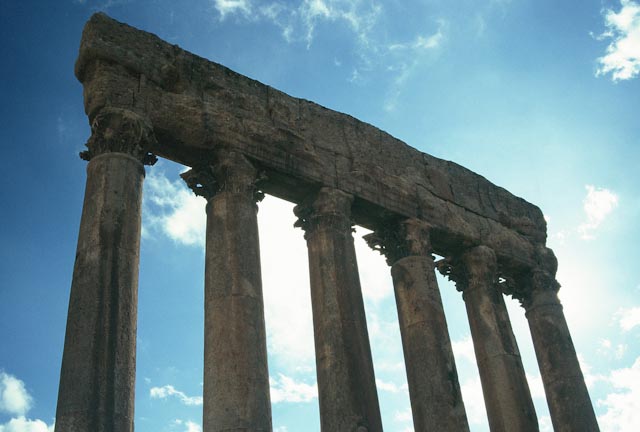White clouds were piping over a sky of the deepest purple when we were clumping around in the moist red clay of Anjar. Soon we all had platform shoes and were being spat upon by the heavens.
As we drove up the Bekaa Valley towards Baalbeck, the rain began to sweep over the Lebanon range in thick white curtains while the Anti Lebanon range was picked out with sunshine.
All the while, the lushness of the surrounding land continued to surprise us: the dark green of the plants, the dark reds and browns of the soils, as well as the many trees. True, we had just come from Syria, which was now suffering from the comparison, but it was only over the mountain range. How could this be?
Lunch was at the Palmyra Hotel and we feasted like royalty for $US10 each. Lebanon is famous for its huge variety of mezzes and we were exposed to a good selection: the obligatory hommus, olives of course (two kinds), potato salads, aubergine dips, green salads, a type of ful, white bean salad, green beans…all deliciously flavoured and spiced. Our main meal consisted of chips, chicken shish and kofte served on heavy skewers, for those who still had room. Fortunately there was ‘only’ fruit for desert, including the indigenous small sweet bananas preferred by all Lebanon’s neighbours, along with Arabian and Turkish coffee.
The room where we ate appealed to us all immediately, as it offered a stark contrast to the cold and dirty wetness outside. The floors of the foyer were cold clean marble and an upright, old-fashioned dresser stood sentry by the front door. Once inside however, we discovered a newly lit fire, still smelling of the kerosene used to start it and a long table laid out with the aforementioned mezzes upon a clean white cloth with sparkling glassware.
Baalbeck surprised us all. I doubt if I have seen any ruins more fascinating (and I am comparing to Rome, Greece and Turkey – Egypt I consider an example apart). What grand scales their builders worked upon. The Temple of Jupiter, famed amongst other things, for its tremendously tall columns which stand at 20 metres excluding the capitals. Plus, they are made of only three separate pieces of stone. There are only six of these might structures left and one can only imagine how the stones for the arches were raised above them.

Purported to have the largest acropolis in the world, the ruins at Baalbeck are a mixture in architectural styles, as the Byzantines, Romans and Ottomans have all had a turn at contributing. The Bachus Temple is probably the single most outstanding building on the site. Apparently complete when viewed from the Temple Jupiter, its carvings are still clear and the structure immense to behold.
Dodging the large puddles resting on the shiny marble, we shivered our way to the bus and drove south back through the Bekaa Valley on our way to Beirut.
The snow beginning to accumulate on the Lebanon range in ancient times was compared to yoghurt, or in the Cannanite language (as well as the modern Arabic) ‘Leban’. This then later became Lebanon. This snow was already in evidence and it was only the beginning of November.

Comments
Total Comments : ( ) You have to register to post a comment.
RECENT COMMENTS